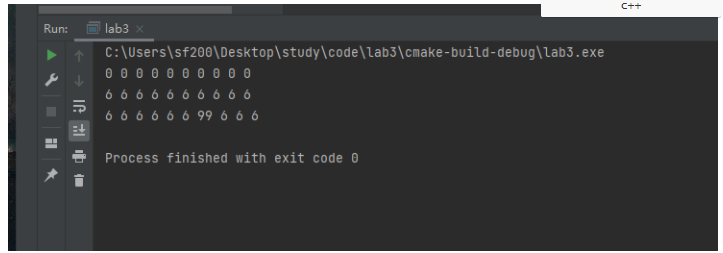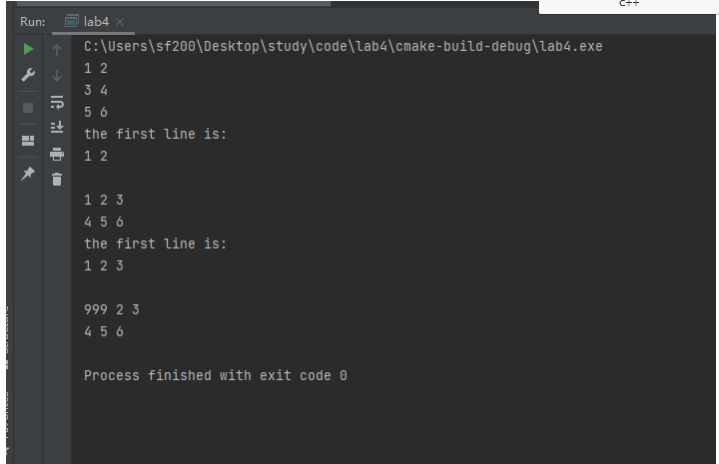实验三:类和对象Ⅱ
任务四:
//Vector_int.h #ifndef LAB3_VECTOR_INT_H #define LAB3_VECTOR_INT_H #include "iostream" using namespace std; class Vector_int { private: int n; int x; int *a; public: explicit Vector_int(int num, int xx = 0) { n = num; x = xx; a = new int[n]; for (int i = 0; i < n; i++)a[i] = x; } ~Vector_int() { delete[]a; } Vector_int(Vector_int &v) { n = v.n; a = new int[n]; for (int i = 0; i < n; i++) { a[i] = v.a[i]; } x = v.x; } int &at(int y) { return a[y]; } void showa() { for (int i = 0; i < n; i++) { cout << a[i] << ' '; } cout << endl; } }; #endif //LAB3_VECTOR_INT_H
//task4.cpp #include <iostream> #include "Vector_int.h" using namespace std; int main() { int n = 10; Vector_int x1(n); x1.showa(); Vector_int x2(n, 6); x2.showa(); Vector_int y(x2); y.at(6) = 99; y.showa(); }

实验五
//Matrix.h #ifndef MATRIX_H #define MATRIX_H #include <iostream> #include <cassert> using namespace std; class Matrix { public: Matrix(int n); // 构造函数,构造一个n*n的矩阵 Matrix(int n, int m); // 构造函数,构造一个n*m的矩阵 Matrix(const Matrix &X); // 复制构造函数,使用已有的矩阵X构造 ~Matrix(); //析构函数 void set(const double *pvalue); // 用pvalue指向的连续内存块数据为矩阵赋值 void set(int i, int j, int value); //设置矩阵第i行第j列元素值为value double &at(int i, int j); //返回矩阵第i行第j列元素的引用 double at(int i, int j) const; // 返回矩阵第i行第j列元素的值 int get_lines() const; //返回矩阵行数 int get_cols() const; //返回矩列数 void print() const; // 按行打印输出矩阵 private: int lines; // 矩阵行数 int cols; // 矩阵列数 double *p{}; // 指向存放矩阵数据的内存块的首地址 }; #endif
//Matrix.cpp #include "Matrixx.h" Matrix::Matrix(int n) { lines = n; cols = n; p = new double[n * n]; } Matrix::Matrix(int n, int m) { lines = n; cols = m; p = new double[n * m]; } Matrix::Matrix(const Matrix &X) { lines = X.lines; cols = X.cols; p = new double[lines * cols]; for (int i = 0; i < lines * cols; i++) { p[i] = X.p[i]; } } Matrix::~Matrix() { delete[]p; } void Matrix::set(const double *pvalue) { for (int i = 0; i < lines * cols; i++) { p[i] = pvalue[i]; } } void Matrix::set(int i, int j, int value) { p[cols * i + j] = value; } double &Matrix::at(int i, int j) { return p[cols * i + j]; } double Matrix::at(int i, int j) const { return p[cols * i + j]; } int Matrix::get_lines() const { return lines; } int Matrix::get_cols() const { return cols; } void Matrix::print() const { int flag = 0; for (int i = 0; i < lines * cols; i++) { if (flag != 0 && flag % cols == 0)cout << endl; cout << p[i] << ' '; flag++; } cout << endl; }
//task.cpp #include <iostream> #include "Matrixx.h" int main() { using namespace std; double x[] = {1, 2, 3, 4, 5, 6}; Matrix m1(3, 2); // 创建一个3×2的矩阵 m1.set(x); // 用一维数组x的值按行为矩阵m1赋值 m1.print(); // 打印矩阵m1的值 cout << "the first line is: " << endl; cout << m1.at(0, 0) << " " << m1.at(0, 1) << endl; cout << endl; Matrix m2(2, 3); m2.set(x); m2.print(); cout << "the first line is: " << endl; cout << m2.at(0, 0) << " " << m2.at(0, 1) << " " << m2.at(0, 2) << endl; cout << endl; Matrix m3(m2); m3.set(0, 0, 999); m3.print(); }


 浙公网安备 33010602011771号
浙公网安备 33010602011771号